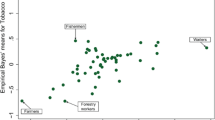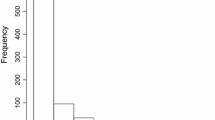Abstract
The conduct of public health surveillance and epidemiologicinvestigations would be enhanced by a cost-effective method for thecollection of population-based cancer risk-factor data. We assessed thefeasibility of ascertaining such data from hospital medical records duringroutine abstraction of information from a cancer registry. We examined themedical records of a representative sample of prostate and lung cancer casesdiagnosed during 1992 and 1993 from the New Mexico (United States) TumorRegistry (NMTR) database. Registry personnel abstracted ancillary informationfrom the medical records of 575 prostate and 273 lung cancer cases. Ofmedical records from 848 cases, 90 percent documented a history of tobaccouse, 77 percent contained any family medical history, and 48 percentdocumented occupational information sufficient to allow coding into standardoccupational groups. Availability of occupation and industry varied bypatient ethnicity, age at diagnosis, marital status , and type of hospital,indicating the potential for bias in studies using occupational informationfrom medical records. Our findings suggest that risk factor informationabstracted from medical records may provide valuable information for publichealth surveillance, but is generally too incomplete to serve as a singlesource of exposure information for etiologic studies. Family histories inmedical records may be sufficient for population-based ascertainment ofaffected relative pairs for genetic epidemiology studies for some cancertypes.
Similar content being viewed by others
References
Doll R, Peto R. The causes of cancer: quantitative estimates of avoidable risks of cancer in the United States today. JNCI 1981; 66: 1191–308.
Brownson RC, Davis JR, Chang JC, et al. A study of the accuracy of cancer risk factor information reported to a central registry compared with that obtained by interview. Am J Epidemiol1989; 129: 616–24.
US Department of Health and Human Services. Healthy People 2000: Midcourse Review and 1995 Revisions. Hyattsville, MD (USA): Public Health Service, 1995.
US National Cancer Institute. Occupation as a carcinogen: federal researcher suggests change in cancer registries. JNCI 1994; 86: 1748–50.
Institute of Medicine. The Future of Public Health. Washington, DC: National Academy Press, 1988.
van Bemmel JH, McCray AT, eds. Yearbook of Medical Informatics 95: The computer-based patient record. Geneva, Switzerland: Schattauer, Stuttgart, 1995.
New Mexico Tumor Registry. State of New Mexico: Malignancies Diagnosed, 1992. Albuquerque, NM (USA): UNM Cancer Research and Treatment Center, 1993.
World Health Organization. International Classification Diseases for Oncology, First Edition. Geneva, Switzerland: WHO, 1976.
Office of Management and Budget. Standard Industrial Classification Manual. Washington, DC: Executive Office of the President, 1987.
Office of Federal Statistical Policy and Standards. Standard Occupational Classification Manual. Washington, DC: US Department of Commerce, 1980.
US Department of Commerce. Characteristics of the Population: General Social and Economic Characteristics: New Mexico: 1990 Census of Population. Washington, DC: Bureau of the Census, 1990.
Swanson GM, Schwartz AG, Burrows RW. An assessment of occupation and industry data from death certificates and hospital medical records for population-based cancer surveillance. Am J Public Health1984; 74: 464–76.
Spitz MR, Currier RD, Fueger JJ, et al. Familial patterns of prostate cancer: a case-control analysis. J Urol 1991; 146: 1305–7.
Whittemore AS, Wu AH, Kolonel LN, et al. Family history and prostate cancer risk in Black, White, and Asian men in the United States and Canada. Am J Epidemiol1995; 141: 732–40.
Wu AH, Fontham ET, Reynolds P, et al. Family history of cancer and risk of lung cancer among lifetime nonsmoking women in the United States. Am J Epidemiol1996; 143: 535–42.
Samet JM, Humble CG, Pathak DR. Personal and family history of respiratory disease and lung cancer risk. Am Rev Respir Dis 1986; 134: 466–70.
Brewster D, Muir C, Crichton J. Registration of lung cancer in Scotland: an assessment of data accuracy based on review of medical records. Cancer Causes Control1995; 6: 303–10.
Napier JA, Metzner H, Johnson BC. Limitations of morbidity and mortality data obtained from family histories-a report from the Tecumseh Community Health Study. Am J Public Health1972; 62: 30–5.
Love RR, Evans AM, Josten DM. The accuracy of patient reports of a family history of cancer. J Chronic Dis 1985; 38: 289–93.
McDiarmid MA, Bonanni R, Finocchiarro M. Poor agreement of occupational data between a hospital-based cancer registry and interview. J Occup Med1991; 33: 726–9.
Bond GG, Bodner KM, Sobel W, et al. Validation of work histories obtained from interviews. Am J Epidemiol1988; 128: 343–51.
Baumgarten M, Siemiatycki J, Gibbs GW. Validity of work histories obtained by interview for epidemiological purposes. Am J Epidemiol1983; 118: 583–91.
Schroeder J, Lamb S. Data initiatives: HEDIS and the New England Business. Am J Med Qual 1996; 1: S58–62.
Author information
Authors and Affiliations
Rights and permissions
About this article
Cite this article
Gilliland, F.D., Larson, M. & Chao, A. Risk factor information found in medical records of lung and prostate cancer cases, New Mexico Tumor Registry (United States). Cancer Causes Control 8, 598–604 (1997). https://doi.org/10.1023/A:1018494313389
Issue Date:
DOI: https://doi.org/10.1023/A:1018494313389




